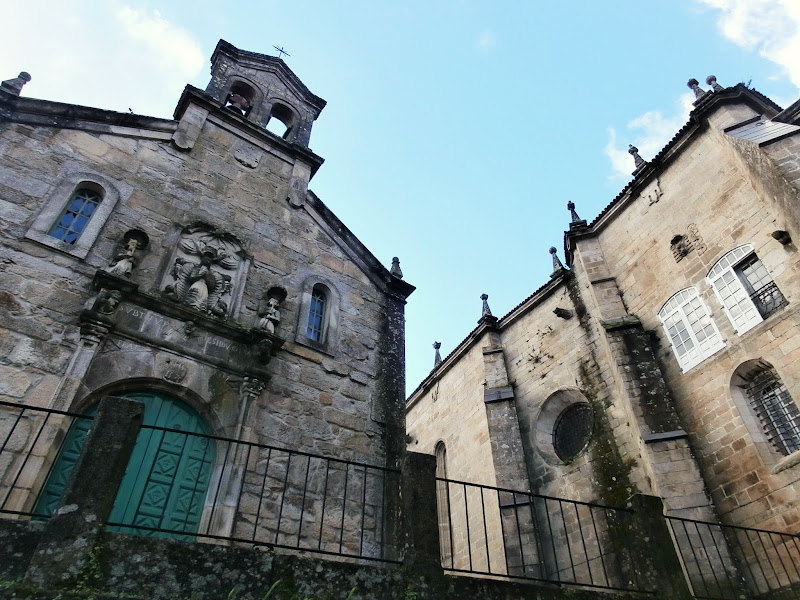We return to Tui, on the banks of the River Miño to the south of the province of Pontevedra. Tui is the entry point of the Portuguese Way of Saint James in Galicia and has important monuments that bear witness to its history.
As is known the Cathedral of Santa María is the most representative monument in Tui. Click here to see our previous visit to the Cathedral of Tui.
We begin the walk right next to the Cathedral in the Capilla de la Misericordia (Chapel of Mercy). Beside it the hostel for pilgrims is located. The Chapel of San Telmo is a few metres down the street. We will retrace our steps to see the Convent of the Poor Clares (or Encerradas).
After going through the tunnel underneath the convent we will go towards the remains of the medieval wall in Porta da Pía and Ordóñez Street. Then we will approach the Church of San Francisco to finish our walk at the Convent of Santo Domingo.
Our starting point: The Capilla de la Misericordia. It is located beside the east façade of the Cathedral (to the right of the picture).
Coordinates to find the location of Tui in Galicia. Extend the map and reach the Capilla de la Misericordia: 42.046196, -8.643919
The Capilla de la Misericordia (Chapel of Mercy) was built the middle of the 16th century. In the early 20th century a reconstruction work was made because of the poor state of conservation. The facade is work of the artist from Tui Melchor Alonso Feal in 1575, in the Renaissance period.
We can see to the left of the picture the hostel for pilgrims.
42.046229, -8.644032
The Capilla is seen from Párroco Rodríguez Vázquez Street which goes down to the hostel for pilgrims and to the Capilla de San Telmo.
42.046196, -8.643919
Tui is a municipality which has a population of approximately 17000 inhabitants. It is located south of the Province of Pontevedra beside the River Miño which separates Spain from neighboring Portugal. The historic area of Tui covers a large area of 1.5 hectares and occupies the hill on which the town stretches. It is an example of medieval city that has maintained its historical appearance completely. There are many houses with ogee arches, coats of arms and construction elements from 16th to 19th centuries.
Capilla de San Telmo (San Telmo Chapel).
This unique work of Portuguese Baroque in Galicia was built between 1769 and 1803 in the place where the saint died (in the 13th century), today patron of the city and the diocese. Its circular floor plan and its cupola stand out, also the niches (https://en.wikipedia.org/wiki/Niche_(architecture)) with representations of San Telmo in the middle and Santo Domingo and San Vicente Ferrer, the three Dominican saints.
42.046155, -8.643498
San Telmo Street.
42.046183, -8.643427
San Telmo.
Santo Domingo de Guzmán.
San Vicente Ferrer.
Convent of the Poor Clares (Order of St. Clare) or “Las Encerradas” (“The locked up ones”).
The Convent has a history of over 500 years as an enclosed convent. It was built between the 17th and 18th centuries, on former Episcopal Palaces of A Oliveira. The inhabitants of the convent known as “Las Encerradas” produce their renowned almendrados (sweets of almonds) and their peces de almendra (almond fishes).
The Church is of Baroque style, it was built in the late 17th century. The vaulted tunnel which passes under the convent stands out.
We can see to the right the tower bell and the façade of the Church and to the left the convent.
42.046963, -8.643966
This is the façade of the church of the convent.
42.046949, -8.643971
42.047079, -8.643858
42.047211, -8.643751
This is the façade of the convent.
42.047274, -8.643721
We can see the convent and the tower bell of the church and the Cathedral of Tui in the background.
42.047274, -8.643721
The tunnel.
42.047274, -8.643721
42.047307, -8.643600
42.047283, -8.643436
From here we walk to the remains of the medieval wall. We will see it in Part 2.
End of Part 1.
Click Here for Part 2.
























No comments:
Post a Comment